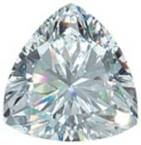|
|
As much as we appreciate nature, there are always those who would add or improve on what the world has to offer.
Just as our ancestors abandoned foraging for food in favor of farming and ranching, so too, modern man has turned to the gem stone lab to produce in quantity what is rarely found in nature.

And why not? What is a gem after all?
It is a substance made up of one or more elements, either in mixture or compound, changed by heat, pressure and chemical processes into a pretty stone.
The term synthetic gem stone, or man made gem stone, must be distinguished from imitation or enhanced gem stones.
A truly created gem stone must be chemically similar to the original, natural version. The cubic zirconium gem stone, though often mistaken for a diamond gem stone, is not made of carbon like the original.
A collection of created loose gem stones may look very much like their natural counterparts.
So why do it!
Why do we go into the gem stone lab and come out with something that is an imitation of the genuine article?
Reason 1 for Man Made Gem Stones:
The real thing is too rare.
This is particularly true of industrial gem stones. The synthetic gem stone has the needed properties without the cost of mining and the competition with the jewelry industry.

Reason 2 for Man Made Gem Stones:
The real thing is too random.
While much of the character of the so called natural gem stone comes from its impurities and random shape.
When creating a ruby laser or a diamond drill, finding just the right stone from natural sources can be a problem. Having a stone 'made to order', on the other hand, has many advantages such as having large man-made gem stones as in the lab created alexandrite gem stones.
Not all stones can be easily synthesized. Some of the most common created gem stones are:
- Diamond:
In the 1950's, various processes were developed to create industrial grade diamonds from pure carbon.
In recent years, these man made diamond gem stones have begun to be produced in gem stone grades and have found their way into the jewelry market. - Ruby and other corundum stones:
One of the earliest products of the gem stone lab, the first synthetic ruby gem stone was created in 1902. Since then the synthetic sapphire gem stones and the spinel joined the ranks of man made stones.
Thought synthetic corundums gem stones are often of jewelry quality; their main significance is still in industrial applications. The first laser beam was created in 1953 using a synthetic ruby crystal.
- Alexandrite:
This beautiful alexandrite gem stone, the color changing stone named after the Russian Czar, had until recently been impossible to synthesize.
Imitations made from corundum compounds have been around for over 100 years, but true man made or created alexandrite gem stones are now available.

- Cubic Zirconia:
- A rare gem stone in nature.
- Easily and commonly synthesized in the gem stone laboratory.
- A stone used to simulate another gem, namely the diamond.
Composed of zirconium oxide, this stone so closely resembles the carbon based diamond that legitimate copies of famous diamonds are made from zirconium for insurance and security purposes.
So, whether for industrial use or decoration or jewelry, the man made gem stone is an important part of our economy.
Click Here to see Samples of Lab Created Gem Stones & Synthetic Gem Stones which we provide